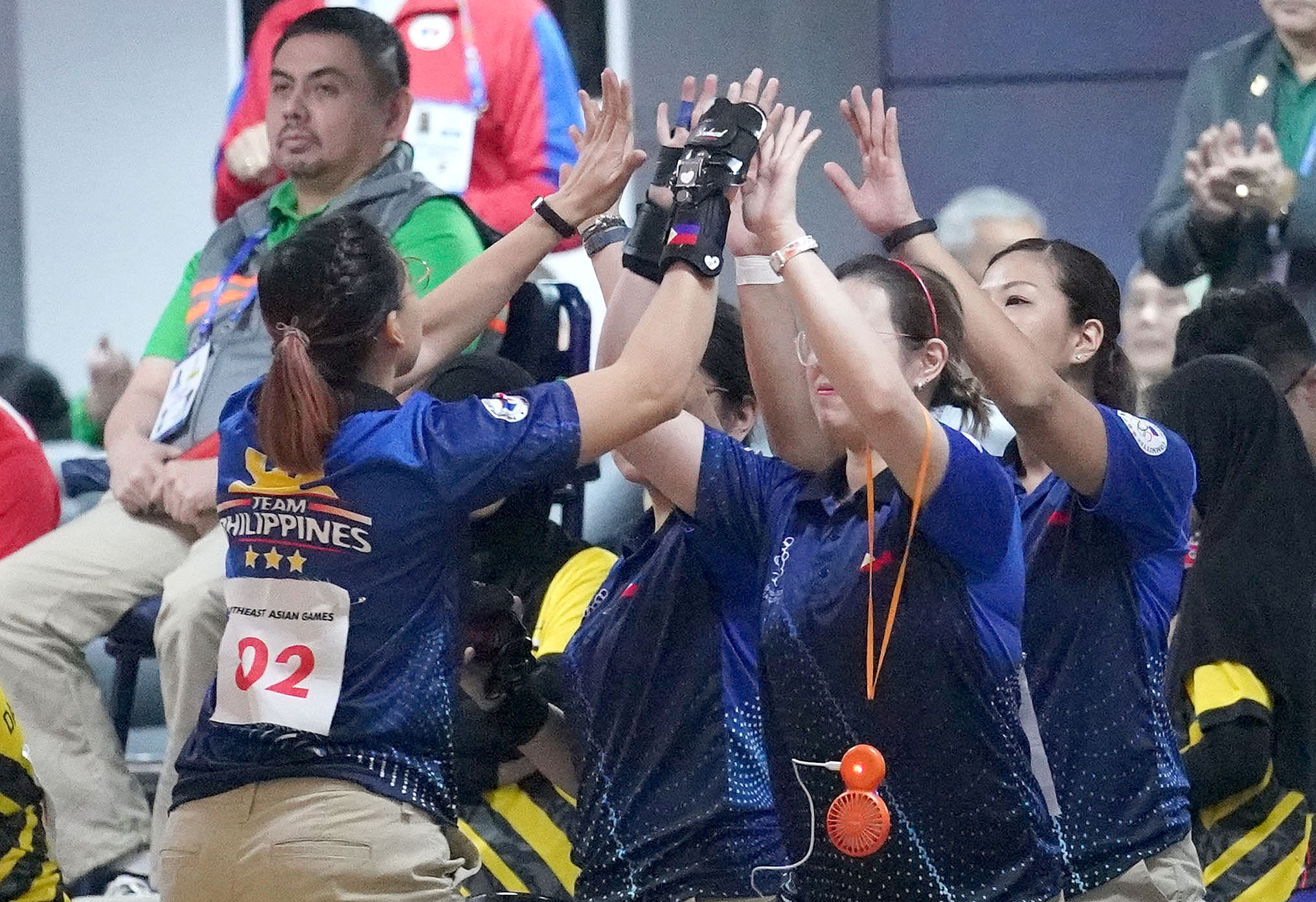Slim pickings could signal turnaround for Philippine bowling

The Philippines’ Team of Four in the bowling competition of the 30th Southeast Asian Games.
INQUIRER PHOTO/AUGUST DELA CRUZ
Some say that the ones who won the silver were actually the ones who lost the gold. That may be so for Philippine bowling not too long ago. These days, however, every medal is golden.
This is no time to be choosy. And that’s how it was at the bowling competition of the 30th Southeast Asian Games.
The demigods of bowling—two Hall of Famers and the other all-time greats of the sport—were there, shouting themselves hoarse to cheer the once-mighty Philippine team going after slim pickings—a silver and a bronze.
“At least, we’re not zero,’’ said Senate President Vicente “Tito” Sotto III, a World Cup and SEA Games veteran who is now one of the sport’s biggest supporter. He joined four-time World Cup champion Paeng Nepomuceno and former FIQ world champion Bong Coo in cheering the Filipino bowlers chase whatever medal they could get in the competition.
Failing to take advantage of their familiarity with the Coronado Lanes at Starmall in Mandaluyong, the Filipinos came up empty after five events—the men’s and women’s singles and doubles and the mixed doubles.
But in the teams of four on Friday, the Filipinos came alive. The men’s team came from fourth place down to capture the silver while the women’s team salvaged a bronze after losing the lead going into the final three-game block. In the men’s and women’s Masters on Saturday, the Filipinos wilted again, falling way back behind the leaders going into Sunday’s final 8-game series and stepladder finals.
After the first eight-game block, Merwin Tan was the highest placed Filipino at fifth place with Patrick Nuqui at seventh. The Filipino women were farther down with Lara Posadas-Wong at 12th, Bea Hernandez at 13th and Alexis Sy at the bottom at 16th.
Even before the last ball was rolled in competition, Sotto and the two bowling greats plotted the return of the Filipinos, once a world power in the sport, back to its position of preeminence.
Just starting
“We have just started,’’ Coo said. She pointed to a new generation of young talents who could carry the Philippine banner in its bid to return to the top. “We have what it takes to make a comeback, if only we have the facilities and the finances to support us.”
Since dominating the bowling competition in the SEA Games in 2005 in Manila, the Filipinos have not seen the top of the podium except for Frederick Ong, who won the men’s singles in 2011.
The 2005 Games was seen as the Filipinos’ last great show in bowling—they won four golds and six silvers. From that plateau, it was downhill for the Filipinos. If not for Ong’s gold, it would have been a long, long gold medal drought. A few silvers and bronzes were all they could win after that.
Expensive game
How the mighty had fallen. But how did it come to this?
Sotto and Coo have one simple explanation: money, or lack of it.
Bowling has become a very expensive game, Coo said. And she’s not talking about the essentials—balls, shoes, bags and other equipment. She’s referring to the other costs of playing the game at the bowling centers.
These days, it costs P140 per game to play in the bowling alley. Ten games means P1,400 and that’s not even enough to work out a sweat for a bowler hoping to develop his skills. To have a good workout for the day, one has to play at least 18 games.
When Coo, Nepomuceno and Sotto were at their peak a few decades ago, the cost was only two pesos per game. And it didn’t hurt that Nepomuceno married into a family that runs the country’s biggest chain of bowling and billiards centers. (He now runs the Coronado Lanes where the SEA Games bowling competitions are being held).
“For two pesos per game, we could play all day and even late into the night,” Sotto said. The exposure honed the future senator enough to earn him the right to represent the Philippines in the World Cup in 1978 in Bogota, Colombia, and 1985 in Sydney, Australia.
The rising cost of the game here and the emergence of regional rivals like Singapore, Thailand and Malaysia contributed largely to the decline of the Philippines in the SEA Games, Sotto said.
“There was a time when our rivals would tremble in our presence,” Sotto said. “They don’t fear us anymore.””
Sotto, the president of the Philippine Bowling Federation, plans to use his clout as Senate President to execute an an ambitious program to return to power in bowling.
He said he would push for the establishment of a national bowling center that would serve as training ground for bowling and start a grassroots program to cull talents from the underprivileged.
He is looking at New Clark City, where many of the SEA Games events are being held, as site of the bowling center. He said he would talk to Vince Dizon, president and CEO of the Bases Conversion Development Authority, to set aside a portion of the sprawling complex for the center. Once completed, the center will be run by the Philippine Sports Commission, which will use it to develop young talents and train national bowlers for international competition.
Coo said the Philippines has a deep reserve of bowling talents, which when harnessed, will restore the country as a bowling superpower once again. Rebuilding, however, will take several more years of humiliation before it is accomplished. INQ














